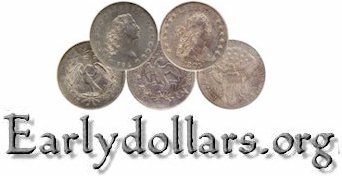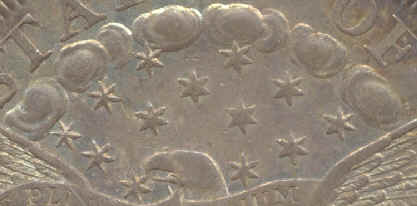

|
Production of Draped Bust dollars dated 1798 with the new “large” or “heraldic” eagle reverse represented a significant increase in mintage from prior years. Accordingly, more dies were needed to carry out production, and the total mintage ultimately employed 17 known different obverse dies and 19 known different reverse dies. These combined to create 31 different individual die varieties and multiple Redbook types. The Redbook categorizes these by the font used for the number “9” in the date, the width of the date, the number or arrows on the reverse, and by the number of lines in the stripes of the reverse shield. The combinations of these characteristics create five different Redbook types. The earliest obverse dies display a date featuring a “9” with a rounded knob at the base, as had been in use since 1794, and the earliest reverse dies depicted a shield with 5 vertical lines or “stripes” in each of the 6 major vertical stripes in the shield. Accordingly, the very earliest of the 1798 Draped Bust/Large Eagle dollars combine the “Knob 9” obverse with the “5 Stripe” reverse. Labeled the “5 Stripe” type, an estimated 1,000 combined specimens still exist for all varieties with the “5 stripe” feature. With the next set of reverse dies, the Mint adopted its standard of 4 vertical lines in each of the 6 major stripes in the shield. Varieties resulting from the combination of these newer reverse dies with the “Knob 9” obverse dies, are labeled the “Knob 9” type. It is estimated that approximately 1,300 specimens remain of all of the Knob 9/4 Stripe varieties combined. |
|
|
|
|
|
Knob 9 Date Style |
|
|
|
|
|
5 Stripe Shield |
4 Stripe Shield |
|
With the next set of obverse dies, the Mint adopted its new font, featuring a newly designed “9” with a pointed tail at the base. This pointed style of the numeral “9” continued in use for all succeeding mintages of early dollars. Certain obverse dies bearing “Pointed 9” dates were prepared with the numerals of the date closely spaced, while others were prepared with the numerals widely spaced. An estimated 4,600 specimens are thought to remain in existence for all of the “Pointed 9 Close Date” varieties combined. At around this time, the Mint prepared (presumably inadvertently) certain of the reverse dies showing only 10 arrows, rather than the normal 13. Consequently, Pointed 9/Wide Date obverses were sometimes matched with 10 Arrows reverses and sometimes with 13 Arrows reverses. An estimated 1,100 specimens are thought to remain in existence for all of the “Pointed 9 Wide Date 10 Arrows” varieties combined, and an estimated 2,300 specimens are thought to remain in existence for all of the “Pointed 9 Wide Date 13 Arrows” varieties combined. |
|
|
|
|
|
Pointed 9 Close Date |
Pointed 9 Wide Date |
|
|
|
|
10 Arrows |
13 Arrows |
|
In addition to the distinctive features recognized in the Redbook, Draped Bust/Large Eagle dollars of 1798 also display other very distinctive features. One widely re-used obverse die bears the “Pointed 9 Close Date” style, but with the numeral “8” noticeably out of alignment and placed too high. This obverse die was combined with a number of different reverse dies for the year. |
|
|
|
|
|
Pointed 9 Close Date Normal 8 |
Pointed 9 Close Date High 8 |
|
Reverse dies of 1798 also show some additional distinctive features, even beyond the differences between 5 Stripes and 4 Stripes and between 10 Arrows and 13 Arrows. While all of the reverse dies display an arrangement of 13 stars above the eagle’s head, some of the dies show the stars arranged in intersecting straight lines, while others show the stars arranged in nicely curved arcs. Both the “Line Star” and “Arc Star” reverses were combined with each of the different date style obverses, thereby creating quite a number of distinctive combinations. |
|

|
|
|
Line Stars Reverse |
|
|
|
|
|
Arc Stars Reverse |
|